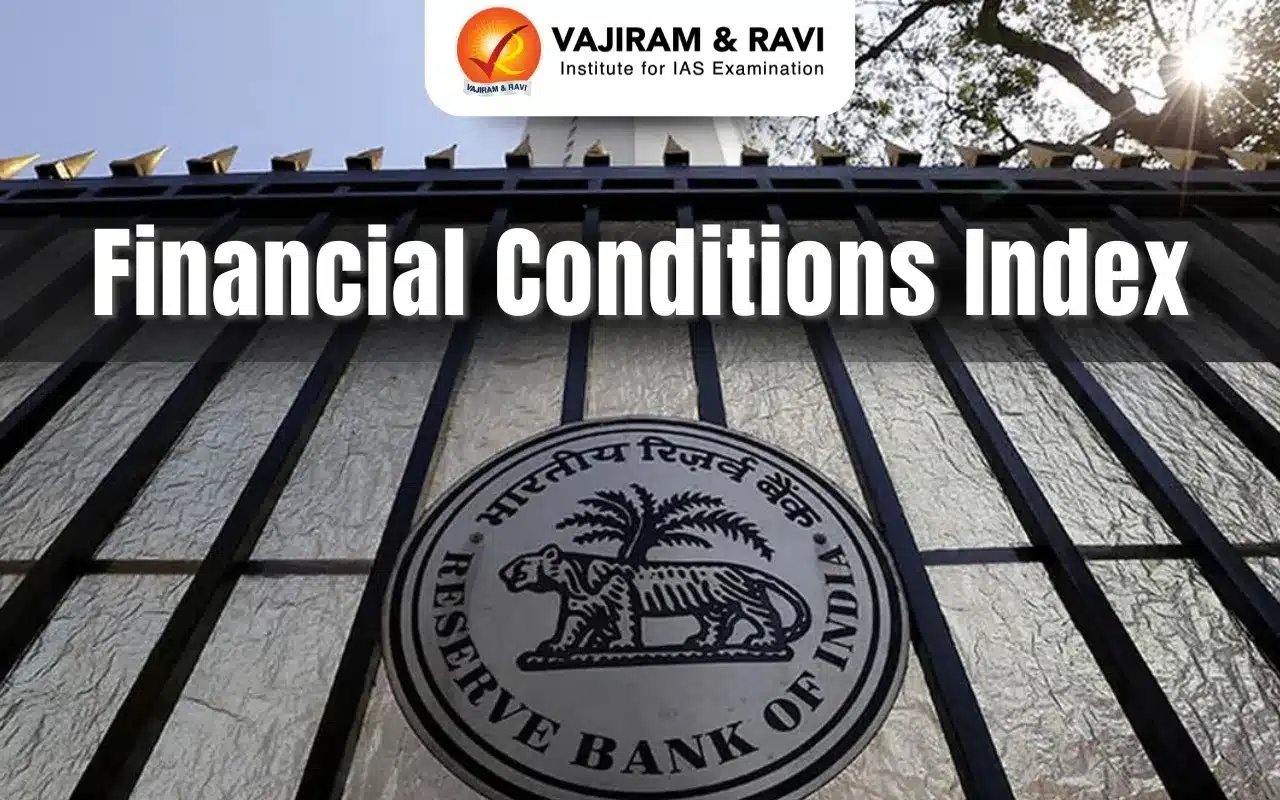Financial Conditions Index Latest News
- In a bid to enhance real-time monitoring of the country’s financial health, a recent study by the Reserve Bank of India (RBI) has proposed the construction of a Financial Conditions Index (FCI) for India with a daily frequency.
Introduction
- To enhance real-time assessment of India’s financial ecosystem, the Reserve Bank of India (RBI) has proposed a Financial Conditions Index (FCI) with a daily frequency.
- The FCI is a composite indicator that aggregates data across major financial segments to evaluate how tight or relaxed financial conditions are, relative to their historical average since 2012.
- This move aligns with global central banking practices, where FCIs help gauge monetary transmission, inform policy decisions, and signal systemic stress.
Purpose and Structure of the Financial Conditions Index
- The proposed FCI aims to serve as a dynamic and high-frequency barometer of India’s financial stability by integrating data from:
- Money Markets
- Government Securities (G-Sec)
- Corporate Bonds
- Equity Markets
- Foreign Exchange Markets
- According to the RBI study published in its June 2025 Bulletin, the FCI is designed to:
- Measure the ease or tightness of financial conditions daily.
- Capture trends across calm and volatile phases.
- Serve as a macro-financial surveillance tool for policymakers.
- The FCI is built using 20 market-based indicators, and values are standardised to reflect changes in financial tightness or looseness in standard deviation units. A positive value indicates tighter conditions, while a negative value suggests easier financial conditions.
Evolution of Financial Conditions in Recent Years
- Post-Pandemic Recovery and Easy Financial Conditions
- The COVID-19 pandemic led to a dramatic tightening of financial conditions due to a sharp sell-off in equity and corporate bond markets.
- However, this was followed by an exceptionally loose financial environment in 2021-2022, driven by the RBI’s proactive interventions, including:
- Large-scale liquidity infusion
- Policy rate cuts
- Regulatory forbearance measures
- During this period, the FCI reached a low of -2.197 in mid-June 2021, indicating extremely easy financial conditions.
- Periods of Tightening
- Significant peaks in the FCI were observed during historical stress episodes, such as:
- July 2013 Taper Tantrum: A peak of +2.826, primarily driven by tightening in bond and forex markets due to fears of US Federal Reserve tapering.
- September 2018 IL&FS Crisis: Equity and bond markets contributed to financial tightening, reflecting stress in the NBFC sector.
- Early 2020 COVID-19 Onset: Market panic due to the global economic shutdown led to a sharp tightening again.
Recent Trends and Current Financial Landscape
- Since mid-2023, India’s financial conditions have largely remained easy, aided by:
- Robust equity market performance
- Ample liquidity in the money market
- Supportive government bond yields
- From November 2024, conditions started to tighten slightly, attributed to:
- Rising global financial uncertainty following the US presidential election
- Changing risk perception in bond and equity markets
- Policy normalisation by global central banks
- However, by March 2025, the FCI moderated and returned to near-neutral levels, signalling stabilisation.
Significance and Policy Implications
- The introduction of a daily FCI is expected to strengthen India’s macro-financial analysis toolkit. Key implications include:
- Real-time Monitoring: Enables early identification of stress build-up or excess exuberance.
- Policy Calibration: Supports timely and data-backed monetary and fiscal policy decisions.
- Market Guidance: Offers insights to financial market participants regarding liquidity and systemic risk.
- Globally, FCIs are used by institutions like the US Federal Reserve and European Central Bank. For India, a customised FCI tailored to its unique market dynamics will aid in improving monetary transmission and crisis management.
Future Outlook
- As India’s financial architecture becomes increasingly complex, the RBI’s daily FCI will play a pivotal role in ensuring financial stability.
- By offering a unified, real-time view of multiple market segments, it empowers both policymakers and investors with actionable intelligence.
- Continued refinement of the index, such as inclusion of newer market indicators, algorithmic adjustments, and integration with other macroeconomic dashboards, can further enhance its utility.
Last updated on January, 2026
→ Check out the latest UPSC Syllabus 2026 here.
→ Join Vajiram & Ravi’s Interview Guidance Programme for expert help to crack your final UPSC stage.
→ UPSC Mains Result 2025 is now out.
→ UPSC Notification 2026 is scheduled to be released on January 14, 2026.
→ UPSC Calendar 2026 is released on 15th May, 2025.
→ UPSC Prelims 2026 will be conducted on 24th May, 2026 & UPSC Mains 2026 will be conducted on 21st August 2026.
→ The UPSC Selection Process is of 3 stages-Prelims, Mains and Interview.
→ UPSC Result 2024 is released with latest UPSC Marksheet 2024. Check Now!
→ UPSC Toppers List 2024 is released now. Shakti Dubey is UPSC AIR 1 2024 Topper.
→ Also check Best IAS Coaching in Delhi
Financial Conditions Index FAQs
Q1. What is the Financial Conditions Index (FCI) proposed by RBI?+
Q2. Which market indicators are included in the FCI?+
Q3. When was the financial condition in India at its tightest?+
Q4. Why is the FCI important for policymakers?+
Q5. How has India’s financial condition evolved in 2025?+
Tags: financial conditions index mains articles upsc current affairs upsc mains current affairs

















